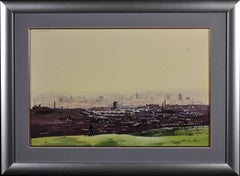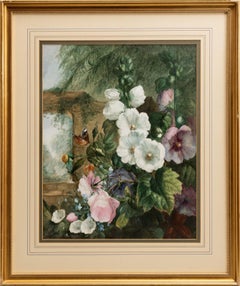Robert Littleford Landscape Drawings and Watercolors
to
1
Overall Width
to
Overall Height
to
1
1
1
1
1
143
123
66
60
1
1
Artist: Robert Littleford
Oldham The Surrounding Hills Greater Manchester Cityscape Original Watercolor
By Robert Littleford
Located in Sutton Poyntz, Dorset
Robert Littleford.
English ( b.1940 – d.2023 ).
Oldham From The Surrounding Hills, 1984.
Watercolor.
Signed & Dated Upper Left.
Image size 14 inches x 21.3 inches ( 35.5cm x 54cm )...
Category
Late 20th Century Naturalistic Robert Littleford Landscape Drawings and Watercolors
Materials
Watercolor
Related Items
Hollyhocks and Roses in a Garden with Butterfly
Located in Stockholm, SE
This is a beautiful and highly decorative watercolor painting, featuring a charming garden scene filled with pink and white hollyhocks alongside blooming roses. Nestled among the del...
Category
Late 19th Century Naturalistic Robert Littleford Landscape Drawings and Watercolors
Materials
Paper, Watercolor
$1,554
H 31.11 in W 26.38 in D 1.19 in
Sunrise Over Mt. Fuji, Japanese Watercolor Landscape
By Emiko Satsuta
Located in Soquel, CA
Idyllic depiction of Mount Fuji by Japanese artist Emiko Satsuta (early 20th Century). Muted colors create a serene atmosphere, with Mount Fuji in the ba...
Category
Mid-20th Century Naturalistic Robert Littleford Landscape Drawings and Watercolors
Materials
Watercolor, Cardboard, Paper
$2,850
H 15.75 in W 38.5 in D 0.75 in
The Angler on Riverscape
By William Bradley Lamond
Located in Hillsborough, NC
Lovely 19th century watercolor painting with an angler in a mountain stream landscape painting, this is signed William Bradley with a place and date on the lower left hand corner. Mists fall over the central mountain rising above the stream with rocks and boulders. A mountain ridge is on the left, and trees above boulders on the right.
William radley Lamond was a self taught artist flourishing from mid to late 19th century. This would be a later work by this artist. The attribution is based on the period, the style the landscape subject and signature.
The painting is presented in an attractive new wooden frame with fresh glass...
Category
1880s Naturalistic Robert Littleford Landscape Drawings and Watercolors
Materials
Watercolor
Jurassic Aloe Leaves, Botanical Cyanotype on Paper, Blue Plants, Nature Details
By Kind of Cyan
Located in Barcelona, ES
This is an exclusive handprinted limited edition cyanotype of a beautiful Aloe plant.
Details:
+ Title: Jurassic Aloe Leaves
+ Year: 2022
+ Edition Size: 100
+ Stamped and Certifica...
Category
2010s Naturalistic Robert Littleford Landscape Drawings and Watercolors
Materials
Photographic Film, Emulsion, Watercolor, Archival Paper, Photographic Pa...
Northern Light: A Winter Scene from Ljusdal
Located in Stockholm, SE
We are delighted to present this enchanting winter landscape by the Sundsvall-born artist Oscar Lycke. Executed in 1911, Motif from Ljusdal captures the serene beauty of a snow-cover...
Category
1910s Naturalistic Robert Littleford Landscape Drawings and Watercolors
Materials
Paper, Watercolor, Chalk, Ink
Charles Culver Landscape Winter Road Watercolor Signed & Dated
Located in Detroit, MI
The idyllic atmosphere of this country scene falls within a couple of styles one being regionalism, an American realist modern art movement that included paintings, murals, lithographs, and illustrations depicting scenes of rural and small-town America primarily in the Midwest and frequently associated with Grant Wood and Thomas Hart Benton. The other style is romanticism wherein the scene depicted is a more desired or dramatic version of what actually is. “Untitled (Winter Road)” is a quiet country scene depicting a road leading into the distance either going to or coming from a local farm. The snow does not particularly seem fresh suggesting a melt and the coming of spring.
This piece has been professionally reframed with acid-free matting and conservator glass.
In a 1952 Detroit Free Press article, entitled “Artist Explains His Work,” Culver was asked why he painted the way he did. He stated: “I try to ‘see’ though not too exactly; I try to think though not too ponderously; I feel emotion yet I try not to become overwrought. I interpret rather than describe, and design rather than depict. I work with values, not light and shade; hence, when I am successful, I achieve substance rather than three-dimensional form, and this satisfies me as being wholly sufficient. In my work I wish to be serious without becoming a bore, exuberant without being frivolous, humorous without being silly. I believe that good paintings are conceived, not contrived; and I am interested in art much more than in pictures.”
Charles...
Category
1940s Naturalistic Robert Littleford Landscape Drawings and Watercolors
Materials
Paper, Watercolor
$1,800
H 18.25 in W 21.75 in
Where Wild Hibiscus Grows, Absecon Island, NJ, Watercolor of Jersey Shore 1894
Located in Philadelphia, PA
Peter Caledon Cameron
(American, born Scotland, 1852-c. 1920)
Absecon Island, New Jersey, 1894
Watercolor on paper, 17 1/2 x 27 inches (sight)
FRAMED: 26 1/2 x 36 1/2 inches
Signed and dated at lower left: "ABSECON.ISLAND./ N.J-U.S.A Cameron/1894" N.J-U.S.A Cameron/1894"
Born in Perth, Scotland, Peter Caledon Cameron won awards for drawing and penmanship at a Glasgow public school. He claimed that at the age of fourteen his watercolors were already "in demand," and that before turning twenty he had "crossed every ocean in the world, sketching and painting as he went." He attended the Government School of Design in London and was certified as an art master in 1883. Cameron immigrated to the United States that year, settled in Philadelphia, and commenced work on large history paintings such as Niagara in Winter (unlocated) and Vesuvius in Grand Eruption (unlocated) that he exhibited in various northern cities. He exhibited one painting at the Pennsylvania Academy of the Fine Arts in 1902. Nothing is known of his activities later in life.
In a lengthy inscription that accompanies this watercolor, Cameron noted that Absecon was "a piece of the best sand-dune region characteristic of the whole coast of New Jersey State from Sandy Hook point in the North to Cape May Point in the extreme south." This was one among a number of studies the artist made for a large oil painting titled "Captain Kidd Burying His Treasure" (unlocated). The famous Scottish privateer Captain William Kidd...
Category
1890s Naturalistic Robert Littleford Landscape Drawings and Watercolors
Materials
Paper, Watercolor
$6,500 Sale Price
23% Off
H 26.5 in W 36.5 in
Palm Leaf Over Blue Sky, Handmade Botanical Cyanotype on Paper, Tropical Vintage
By Kind of Cyan
Located in Barcelona, ES
This is an exclusive handprinted limited edition cyanotype of a beautiful Palm Tree Leaf.
Details:
+ Title: Palm Tree Leaf Over Blue Sky
+ Year: 2025
+ Edition Size: 100
+ Stamped a...
Category
2010s Naturalistic Robert Littleford Landscape Drawings and Watercolors
Materials
Paper, Watercolor, Lithograph
Old Bobbin Mill on the Spey
Located in Hillsborough, NC
William Beattie-Brown is a 19th century Scottish artist, and a master landscape painter using tonal color in a naturalistic style. 'Old Bobbin Mill on ...
Category
1880s Naturalistic Robert Littleford Landscape Drawings and Watercolors
Materials
Watercolor
Nightfall, Original Landscape Drawing, 2018
Located in Boston, MA
Artist Commentary:
A stunning, colorful Texas sunset.
Keywords: Landscape & Nature
Artist Biography:
Judith grew up 15 miles north of Milwaukee in the ...
Category
21st Century and Contemporary Naturalistic Robert Littleford Landscape Drawings and Watercolors
Materials
Paper, Watercolor, Pencil
[CHINESE SCHOOL]. Two Watercolour Scenes.
By 19th Century Chinese school
Located in London, GB
[CHINESE SCHOOL].
Two Watercolour Scenes.
Possibly Canton ca.1820].
Very impressive large scale watercolours of Chinese scenes, presumably executed for the Western market by an an...
Category
1820s Naturalistic Robert Littleford Landscape Drawings and Watercolors
Materials
Watercolor
$55,173
H 39.77 in W 66.93 in D 1.19 in
Beneath the Birch Drawing by Swedish Artist Christian Berg (1893–1976)
Located in Stockholm, SE
We are proud to present an exquisite drawing by the renowned artist Christian Berg (1893-1976), executed around the 1920s. This captivating artwork port...
Category
1920s Naturalistic Robert Littleford Landscape Drawings and Watercolors
Materials
Watercolor, Board, Pencil
$3,408
H 14.97 in W 11.62 in
Robert Littleford landscape drawings and watercolors for sale on 1stDibs.
Find a wide variety of authentic Robert Littleford landscape drawings and watercolors available for sale on 1stDibs. You can also browse by medium to find art by Robert Littleford in paint, watercolor and more. Not every interior allows for large Robert Littleford landscape drawings and watercolors, so small editions measuring 29 inches across are available. Customers who are interested in this artist might also find the work of Bruno Surdo, André Roland Brudieux, and Charles De Wolf Brownell. Robert Littleford landscape drawings and watercolors prices can differ depending upon medium, time period and other attributes. On 1stDibs, the price for these items starts at $1,812 and tops out at $1,812, while the average work can sell for $1,812.


